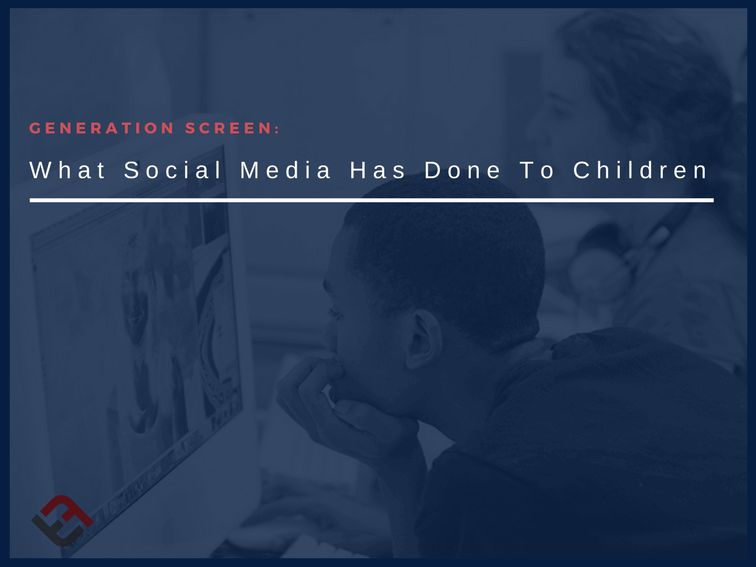
What Social Media Has Done To Children
by Terry Heick
This post was originally written in 2013 and most recently updated (mainly updating dates and swapping the Vine reference for TikTok) in 2021
Google launched more than 20 years ago, in 1998.
Facebook launched in 2004.
The iPhone launched nearly 15 years ago, in 2007.
That means your average student has never known a world without Google, and many don’t remember life without handheld screens and TikTok and Snapchat and YouTube and Facebook and Instagram. Some students even have parents who ‘Googled’ when they were younger, which makes them second-generation Googlers. To many, search and social are the internet.
The uniquity of screens and the ability to Google ‘things’ was an extraordinary cultural leap that we now take for granted. So many cultural patterns were simply wiped out by the ability to pick up a phone and find the most obscure information at any time. It connected anyone with the most random, odd, or fascinating tidbits with a few keystrokes.
Students that have grown up on screens are a kind of mash of social media, YouTube, and search engine which has given them a unique view of reality. Different things have credibility in their eyes.
This matters for teachers, of course, because we need to know what has credibility in their eyes. What they respond to. What makes them tick.
Below I brainstormed some ways social media specifically has impacted children. Clearly, this is a mix of curmudgeonly, old-fashioned hot-takes and gross over-generalizations. Which is fine for me. I have four children who’ve all been raised on screens, so even if we limited our data set to those four while honoring their unique circumstances (middle-class family where every child over eight has their own device, where wifi is plentiful, and where two teachers as parents do their best to help those children understand the impact of said technology on their perspectives and behaviors), I hope it’s at least useful to get a conversation started.
The themes are simple enough: being rebellious, social while thinking of privacy differently, and always in search of connections, notifications, and digitally-sourced dopamine. But there may be some takeaways we can use to adjust our craft if we pay close enough attention.
Generation Screen: What Social Media Has Done To Children
They see less distinction between local events and global events.
They have strong opinions, but may not be used to articulating or evaluating that opinion in sustained terms and contexts.
They hate being alone, or believe they never are. Or have a different definition of alone/lonely than the previous generation.
They see privacy as scalable, not binary.
They see WiFi as a necessity.
They use the word ‘friend’ differently.
‘Bedtime’ is screentime rather than ‘lose consciousness’ time.
They judge others based on technology literacy.
They’re more aware of other countries, cultures, and customs.
Empathy seems to come more naturally–or at least is more visible when it’s missing.
They all slouch.
They tolerate cracked screens disturbingly well.
They see social media tagging as a hug–or a cold shoulder. It is a kind of communication–can be like waving hello or passive-aggressive bullying.
They tend to see the nuance in follower counts–fake versus real, engaged versus unengaged, etc.
How quickly someone does/does not respond to messages is a big deal (e.g., ‘being left on read’)
They have a sense of entitlement about being entertained. Screens are ‘me’ devices designed and customized by the user–through apps and home screen design and wallpaper and notifications-to be ‘fun.’
They’re not used to doing nothing.
They have a new scale for boredom. Circumstances that would have thrilled a child from 1955 to pieces would make a child from ‘Generation Screen’ want to ‘literally die.’ (Using the word ‘literally’ wrong is another modern gift.)
They favor brief bursts of communication (as opposed to extended dialogue). I often hear it said that they don’t know how to have a conversation. I don’t think that’s true–they just have them differently.
Instagram models and YouTubers are the new rock stars.
They want to travel because they’ve grown up seeing more of the world through social media.
Smartphone brand/operating system is an aesthetic.
Sliding in someone’s DMs, or having yours ‘slid into’, is both courtship and failure of courtship.
They tend to see relationships as ‘deletable.’ (The block button on any social media is like Thor’s hammer.)
They believe media should be free (music, games, downloads, apps, etc.).
They think everyone needs to know where they are and what they’re doing at all times, and how they’re responding to said events moment by moment. In this way, they see even physical experiences in ‘digital’ terms.
They see social media as the most tempting way to pursue social justice.
They can mistake an opinion as identity, and thus have trouble dialoguing with people that think differently than they do. (To be fair, this extends to adults on social media as well.)
They have a new scale for ‘old,’ and ‘new’ and ‘current.’ A video from last year can be seen as barely worth watching, where previous generations collected DVDs by the hundreds, presumably to watch more than once.
They see television ‘seasons’ as 72-hours worth of entertainment (e.g., binge-watching on Netflix).
They have a lower standard for quality for video games. What passes as ‘addictive’ and earns companies tens of millions of dollars in microtransactions today is barely passable as a game to ‘gamers’ in their 30s and 40s accustomed to AAA titles with hundreds of hours of open-world gameplay. (Edit: In hindsight, I’m not sure this is fair or true.)
They see knowing what’s old and new, for example, as a kind of identity maintenance.
Things that are ‘viral’ can be seen as preferable to things that endure.
To extend some of this thinking, below are some things that have credibility with kids of the screen generation.
1. Peer pressure (it’s just social media-based)
2. Social traction (it’s the new popular)
3. Instagram
4. Remixing, mashing, or otherwise repurposing anything that’s already been done–music, video games, videos, etc.
5. Randomness (my 12-year-old points out ‘random’ things all the time)
6. gif animations (especially using iconic gif animations to reflect your response to social events)
7. Equity; sustainable business practices (social visibility for greedy, large corporations has imbued Google kids with at least an awareness of sustainability)
8. Communicating complex emotions through emoticons and memes (though these are evolving as well)
9. Unboxing things. Anything, really. Just video it
10. Typing speed
11. Diversity & acceptance (as opposed to mere ‘tolerance’) of different cultures, races, religion, sexual preference, etc.); philanthropy
12. Acronyms (especially ‘inside’ acronyms that obscure communication from adults)
13. Pranks, fails, and cats. Lots and lots of cats.
14. Eyebrows and attractive people/style/fashion/makeup/6-packs (a byproduct of the social, selfie-generation?)
15. New ideas about gender and identity
16. Socially-conscious hip-hop (gangsta rap is out in the mainstream, replaced by hip-hop that defies what their parents think of hip-hop)
17. ‘Nerds’ (not all nerds, but being smart isn’t as brutal today as it might’ve been in the past)
18. Defriending/unfollowing/upvoting/downvoting as social statement
19. Soccer (or football–well, football outside the U.S., soccer here, which–well, nevermind)
20. Coding (teenage millionaires have a way of getting their attention)
21. XP (experience points–as in a gamification system, for example)
22. Lyft/uber > car ownership
23. Mobile interfaces for anything–Starbucks ordering, Googling random things at 3 a.m., Pokémon Go, alerts and notifications, etc.
24. Time ‘alone’ to interface with that screen
Generation Screen: What Social Media Has Done To Children; Things That Have Credibility with Students That Have Grown Up On Screens

